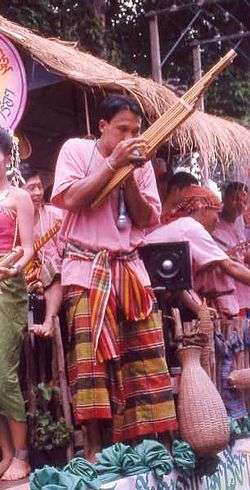Music of Laos
The music of Laos has evolved ever since the migration of the Tai peoples (which includes the Lao and Thai peoples) out of China into present day Laos, where cross-pollination with the indigenous music of the region, as well as importation of Chinese and Mon-Khmer influences, has had a pronounced effect on the instrumentation and melodies of the various forms of music that now exists in Laos. The most popular form of traditional Lao music is mor lam.
Today, Laos lacks a robust music industry. Much of the Lao music produced today comes from Thailand, where many forms of Lao music, particularly mor lam, enjoy massive popularity due to very similar languages and lifestyles.
Lao music
Lao folk music, known as Lam, is extemporaneous singing accompanied by the khene. The Lao people also like to listen to some popular African music.
Mor lam
Ensembles typically include two singers (mor lam, the same term referring to the genre of music) - one male and one female -, a khene player (mor khaen), and other instruments including fiddles, flutes and bells. Music varies widely across Laos, with the lam saravane style being most popular, while the city of Luang Prabang is known for a slow form called khaplam wai. An extremely popular form developed in Thailand is called mor lam sing, and is faster and electrified.
Popular music
In the 1960s, Thai lam nu and lam ploen contributed to the development of lam luang, which is a form of song (and dance) which often has narrative lyrics.
Instruments
- The most distinctive Lao musical instrument is a bamboo mouth organ called a khene. The instrument was supposedly invented by a woman trying to imitate the calls of the garawek bird. The woman took the new instrument to her king, and he told her it was fair, but that he wanted more. She modified the instrument and he replied "Tia nee khaen dee" (this time it was better).
References
- Clewley, John. "Beyond Our Khaen". 2000. In Broughton, Simon and Ellingham, Mark with McConnachie, James and Duane, Orla (Ed.), World Music, Vol. 2: Latin & North America, Caribbean, India, Asia and Pacific, pp 170–174. Rough Guides Ltd, Penguin Books. ISBN 1-85828-636-0.
External links
- (French) Audio clips: Traditional music of Laos. Musée d'ethnographie de Genève. Accessed November 25, 2010.
- The traditional music of Laos
- Alexandra Bounxouei music and videos
- www.laomusic.la
- www.laomall.com/artists
- Archives of Traditional Music in Laos
- Lao music page
- Plain of Jars website

